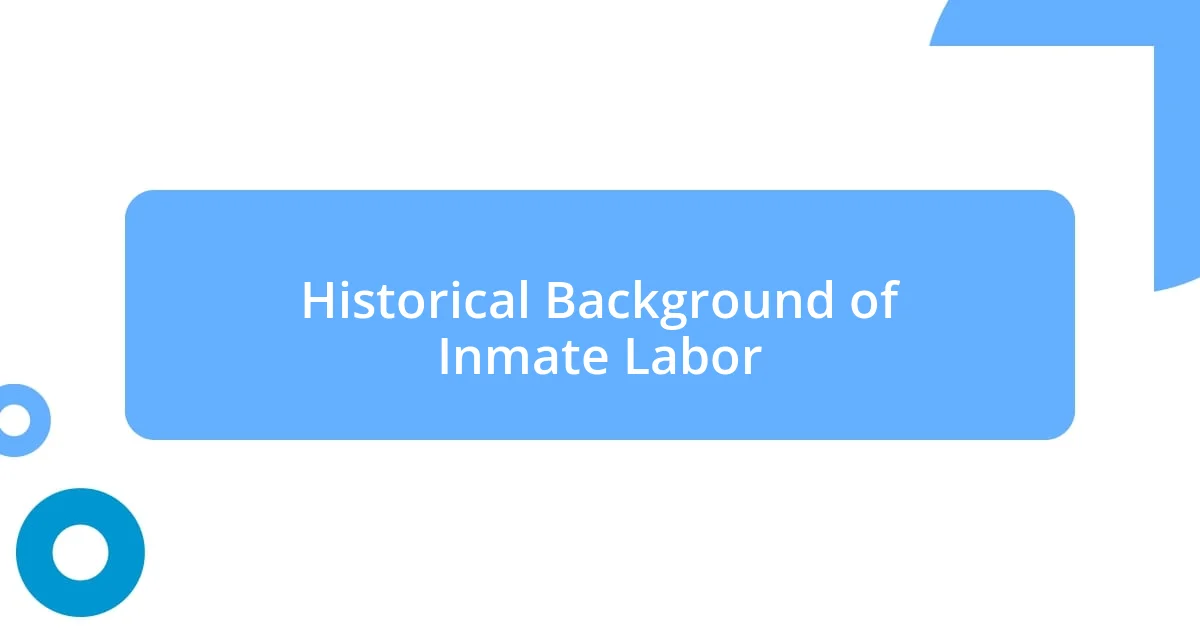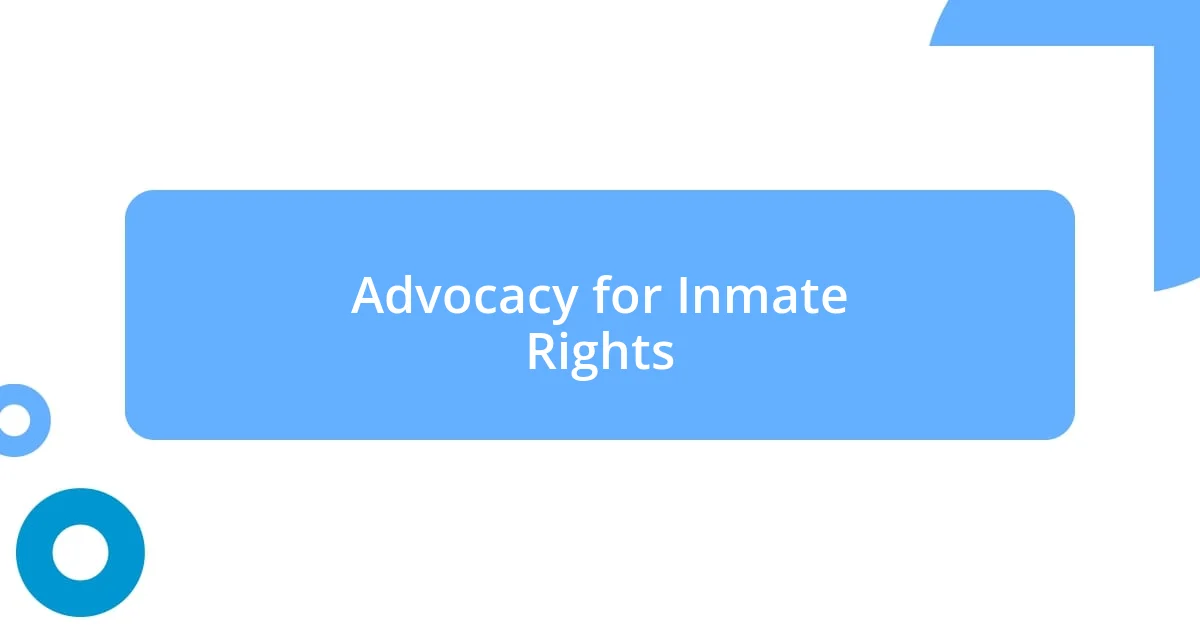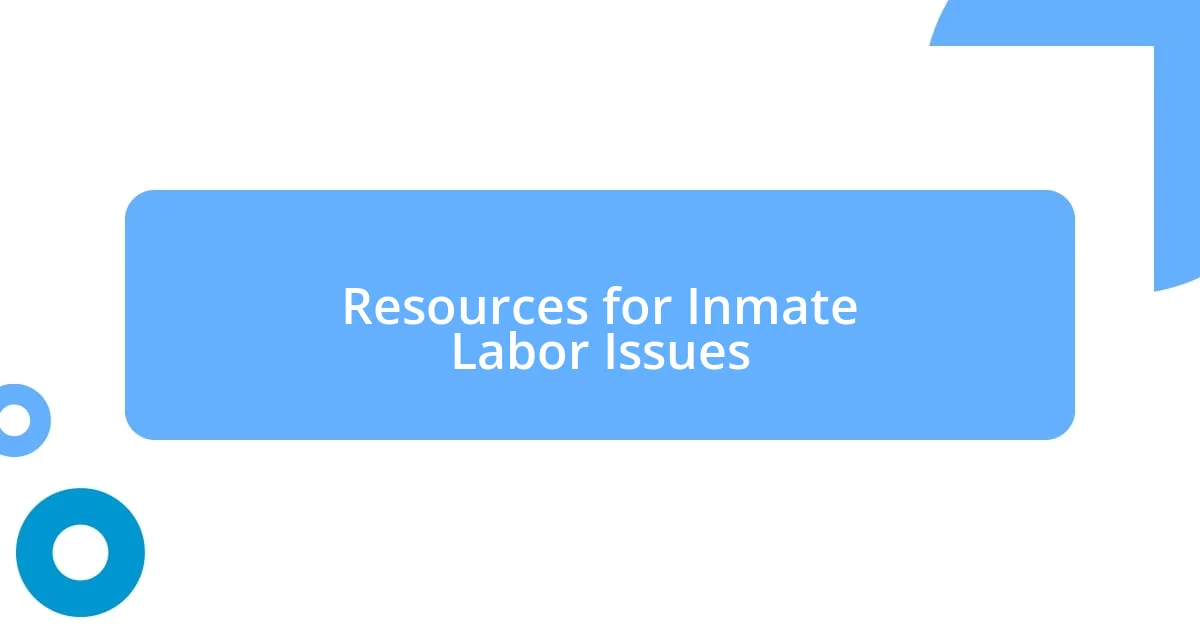Key takeaways:
- Inmate labor often lacks fair compensation and necessary protections, perpetuating cycles of poverty and undermining rehabilitation efforts.
- The 13th Amendment’s exception for “duly convicted” individuals enables the exploitation of inmates under the guise of rehabilitation, raising ethical concerns about labor practices.
- Advocacy for inmate rights highlights the need for dignity and respect, emphasizing that their contributions must be valued fairly to support successful reintegration into society.

Understanding Inmate Labor Rights
Inmate labor rights are often overlooked, yet they are essential to understanding the broader landscape of prison reform. I remember discussing this topic with a former inmate who shared how the work he did in prison, though sometimes fulfilling, paid him a mere fraction of what it was worth. This raises an important question: should inmates only be seen as labor resources, or should their rights and dignity be at the forefront of the conversation?
There’s a significant disparity in how inmate labor is compensated and regulated. I recall a time when I came across a study revealing that some inmates earn less than a dollar an hour, despite working on projects that generate substantial revenue for prison industries. How can we call this fair, especially when many of these individuals lack the opportunity to gain necessary skills or earn a decent wage to support their families upon release?
Exploring inmate labor rights requires us to challenge our perceptions and assumptions. I often wonder about the long-term impact of these labor practices on inmates’ mental and emotional well-being. Can we truly expect individuals to reintegrate into society successfully when they are dehumanized in the very systems designed to rehabilitate them? The answers to these questions may hold the key to reforming not only labor rights but the entire correctional system.

Historical Background of Inmate Labor
Historically, inmate labor dates back to the early days of American correctional institutions, often serving as a means to offset operational costs. From my own observations, it has evolved from chain gangs in the South, where prisoners were forced to toil under harsh conditions, to modern prison industries that profit from the labor of incarcerated individuals. It’s fascinating, yet troubling, to note that this practice has been woven into the fabric of the U.S. criminal justice system for centuries, reflecting deeper societal issues around punishment and rehabilitation.
The 13th Amendment of the U.S. Constitution, ratified in 1865, famously abolished slavery but carved out an important exception for those “duly convicted.” This loophole has allowed the states to exploit inmate labor under the guise of rehabilitation. I have often pondered how this exception has been interpreted over the years. Shouldn’t we reconsider what rehabilitation truly means if it comes at the cost of an inmate’s freedom and dignity?
Additionally, many states have leveraged inmate labor as a cost-effective way to tackle labor shortages, particularly in industries like agriculture and manufacturing. Having talked to numerous advocates for prison reform, I’m struck by how they highlight the need for equitable labor conditions that respect the rights of inmates while providing them with meaningful skills for reintegration. It’s a conversation we need to keep having as we navigate the complex landscape of inmate labor rights and its historical backdrop.
| Historical Era | Key Features |
|---|---|
| Early 1900s | Chain gangs; forced labor with minimal rights |
| Post-13th Amendment | Gained legal backing for exploitation; “duly convicted” loophole |
| Modern Era | Privatization and industries using inmate labor for profit |

Current Laws on Inmate Labor
It’s crucial to understand that current laws regarding inmate labor vary significantly across states. Some states have enacted laws aimed at protecting inmate rights while others remain mired in outdated practices that exploit prisoners. I can recall a workshop I attended where reform advocates passionately described the patchwork of regulations. It was eye-opening to see how these laws dictate not just compensation but also working conditions.
Key points regarding current laws on inmate labor include:
- Federal Standards: The Fair Labor Standards Act (FLSA) generally excludes inmates from minimum wage protections.
- State Variations: Some states mandate a certain percentage of wages to go into a savings account for inmates upon release, while others may not compensate them at all.
- Health and Safety Regulations: There are limited protections for inmates regarding workplace safety, which can lead to hazardous working conditions.
- Educational Opportunities: A few states are beginning to recognize the importance of skill-building programs for inmates, integrating them into labor efforts.
- Voluntary Participation: Many regulations require that inmate labor is voluntary, yet the economic pressures inside prisons can blur the lines of true choice.
Thinking back to some conversations I’ve had, I remember one inmate sharing how he often felt trapped in a cycle; the meager wages he earned felt like a punishing reminder of his status. It’s moments like these that fuel my belief that reform is necessary. The laws governing inmate labor must shift to protect dignity and provide real opportunities, rather than perpetuating a system of exploitation.

Economic Impact of Inmate Labor
The economic impact of inmate labor is far-reaching, often blurring the lines between cost-saving measures for institutions and ethical considerations. I’ve seen firsthand how this practice helps prisons reduce their operating costs, but at what moral expense? It’s unsettling to think about the balance of profits versus humane treatment.
In many states, inmate wages can be as low as a few cents per hour, which benefits the prison system significantly yet falls short of providing any real economic empowerment for the individuals involved. During discussions with advocates for reform, I felt a mixture of frustration and empathy when they described how these low wages contribute to a cycle of poverty for inmates upon release. When inmates exit the system without savings or marketable skills, we wonder: is this truly a path to rehabilitation?
Moreover, the reliance on inmate labor can inadvertently stifle job opportunities for non-incarcerated individuals. I once attended a community meeting where we evaluated local employment needs. The idea that prison industries could keep wages suppressed for everyone was a stark reality that many hadn’t considered. It poses an uncomfortable question: should we prioritize economic efficiency over fairness in the labor market? Such dynamics raise significant concerns about the broader implications of utilizing inmate labor, not just for those incarcerated but for society as a whole.

Personal Experiences with Inmate Labor
Reflecting on my interactions with individuals involved in inmate labor, I vividly remember the story of one inmate tasked with sewing uniforms for various organizations. He spoke of his pride in creating something useful, yet when he detailed his paycheck—just pennies for hours of work—I felt a deep sense of injustice. It left me wondering, can we truly call this labor if it doesn’t provide even a semblance of fair compensation?
During a visit to a facility that housed inmates participating in vocational training, I was struck by the mixed emotions I witnessed. Some inmates shared how these programs sparked a glimmer of hope within them, offering skills they desperately needed for a second chance at life. However, others voiced their uncertainty about whether these skills would truly translate into job opportunities once they were released. How many exit the prison gates only to find the world has little room for them?
I’ve also engaged with advocates who shared harrowing anecdotes of inmate laborers facing unhealthy working conditions. One advocate recounted a story of an inmate injured while working in a cramped kitchen, left with no real recourse for support. This leads me to question the very ethics of these labor practices: if we prioritize profit over people, what kind of society are we building? It’s a topic that requires our urgent attention and action.

Advocacy for Inmate Rights
Advocacy for inmate rights is an essential aspect that often gets overshadowed by discussions of labor practices. I remember attending a rally where former inmates passionately shared their experiences, and it struck me just how vital their voices are in this conversation. Hearing them advocate for fair wages and safe working conditions made me realize that their struggle is not just about compensation—it’s about dignity and respect.
On another occasion, I engaged with a small group of activists working tirelessly to reform sentencing laws. They highlighted how individuals are often incarcerated for non-violent offenses, yet they are trapped in a system that exploits their labor. This leaves me pondering: if we truly believe in second chances, shouldn’t we ensure that their contributions are valued fairly?
One particularly poignant moment for me was witnessing an emotional exchange between an inmate and his family during a visitation. He longed to provide for them, yet the reality of his labor situation left him powerless. This underscores the importance of advocacy efforts that champion basic rights for inmates. What does it say about us as a society if we continue to silence those who are seeking to rebuild their lives? It’s a conversation we can no longer afford to ignore.

Resources for Inmate Labor Issues
I often find myself turning to organizations dedicated to inmate labor rights when I need information or support. For instance, I remember collaborating with the Prison Policy Initiative, which provides an impressive amount of data and analysis on the challenges faced by inmate workers. Their reports opened my eyes to the systemic issues at play, making me realize just how interconnected the various aspects of inmate labor rights truly are.
In my journey, I discovered the importance of legal aid organizations that focus on advocating for prisoners’ rights. One memorable experience was when I attended a workshop by the Southern Center for Human Rights. They shared stories of successful legal battles that improved conditions for inmates engaged in labor. Listening to their firsthand experiences and seeing the impact of their work reinforced my belief that legal support is essential for those seeking justice within a flawed system.
I’ve learned that connecting with local advocacy groups can also be a valuable resource. During one community meeting, I met individuals who had been directly affected by unfair labor practices, and their testimonies resonated deeply with me. How many of us truly understand the harsh reality of these workers? Engaging with such grassroots organizations brings to light the personal stories behind statistics, reminding us that every number represents a life affected by a system that often overlooks their basic rights and human dignity.














